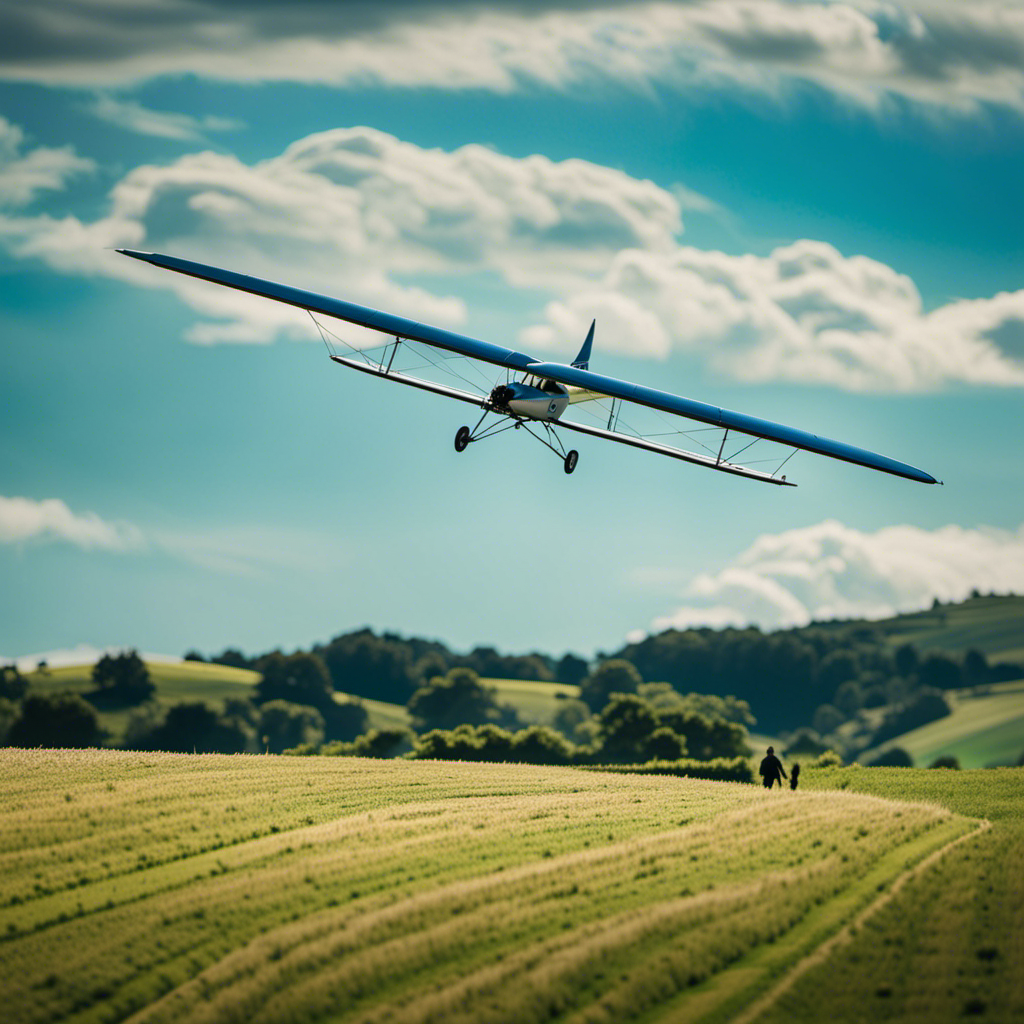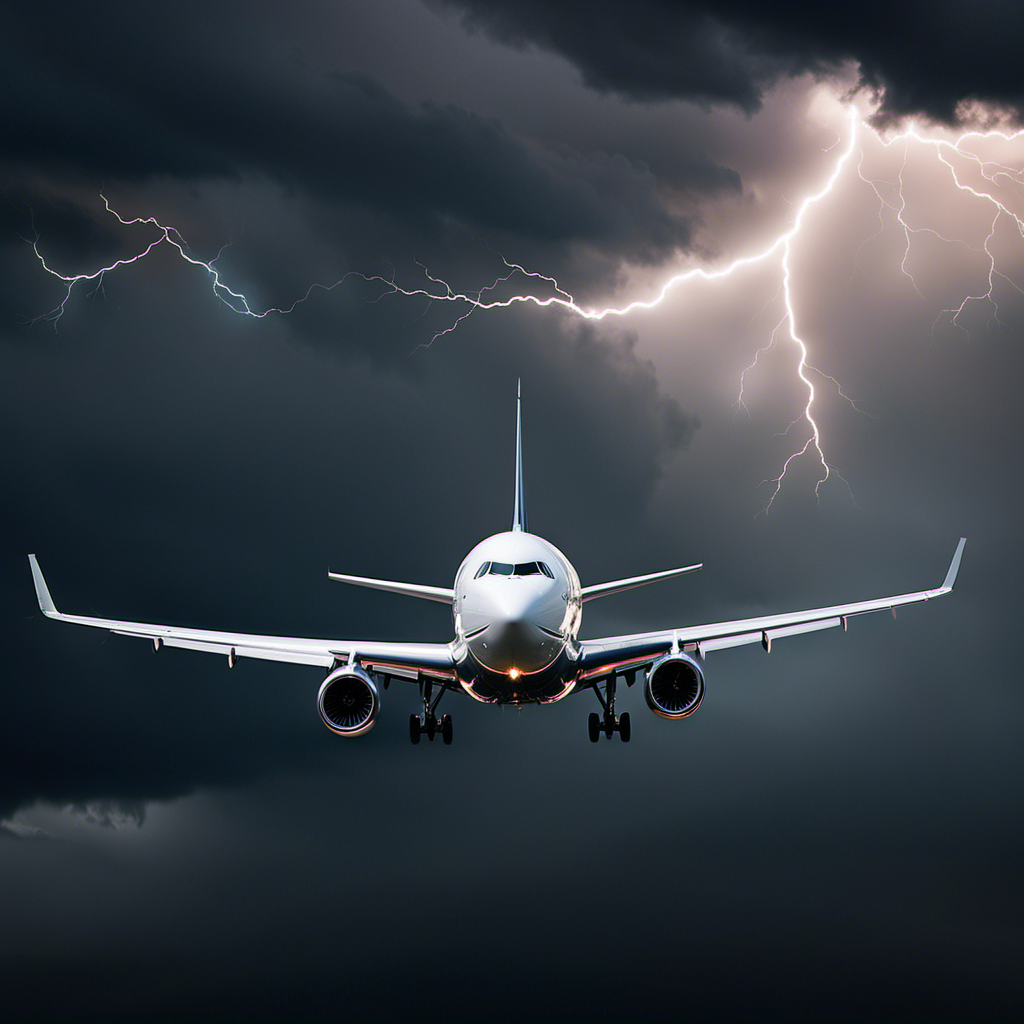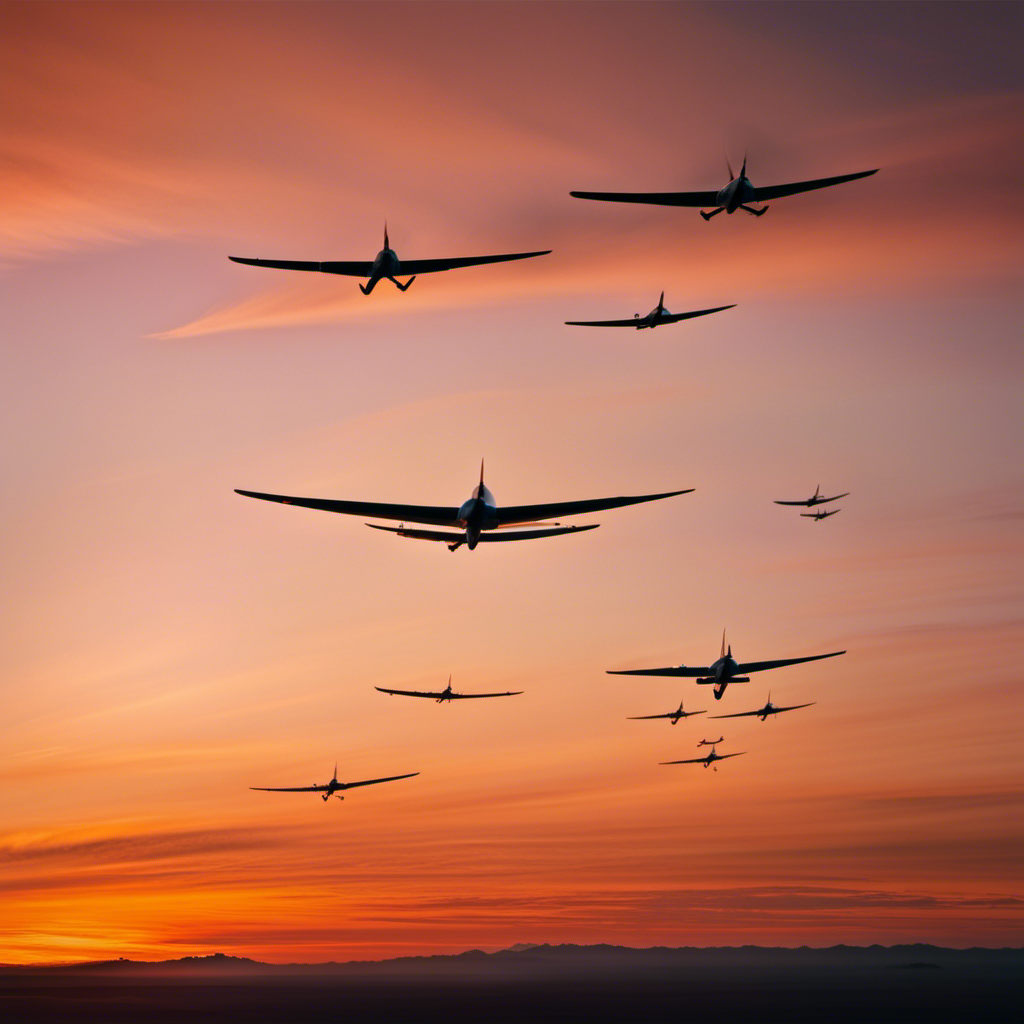The idea of soaring through the air, defying gravity in a glider, has always fascinated me. But, do I have the skills to handle such an impressive aircraft?
With this article, I aim to answer that question. We’ll delve into the basics of glider control, exploring the role of control surfaces and the techniques for maneuvering in different flight conditions.
Whether you’re a novice or an experienced pilot, join me on this journey to unlock the secrets of mastering glider control.
Key Takeaways
- Gliders can be controlled by manipulating control surfaces such as ailerons, elevator, and rudder.
- Ailerons control roll, elevator controls pitch, and rudder controls yaw.
- Control inputs and airspeed directly impact glider performance.
- Techniques for turning, glide ratio, and landing are crucial for safe and effective flying.
Understanding the Basics of Glider Control
Yes, you can control a glider by manipulating the control surfaces. Gliders are designed to be controlled by the pilot through the use of various control surfaces, such as the ailerons, elevator, and rudder. These control surfaces allow the pilot to change the direction and attitude of the glider in flight.
By moving the control stick or yoke, the pilot can adjust the position of the ailerons, which control the roll of the glider. The elevator, controlled by the movement of the control stick or yoke, allows the pilot to change the pitch of the glider. Lastly, the rudder is used to control the yaw of the glider.
Understanding the center of gravity and using trim tabs also play a crucial role in controlling a glider. With these controls and techniques, the pilot can maintain stability and maneuverability in the air.
Transitioning into the next section, these control surfaces are essential for achieving a safe and controlled flight.
The Role of Control Surfaces in Gliders
To maneuver a glider, use the control surfaces like the ailerons and elevators. These control surfaces play a crucial role in glider control techniques and have a direct impact on the glider’s performance.
The ailerons, located on the wings, are responsible for controlling the roll of the glider. By deflecting the ailerons upward on one wing and downward on the other, the glider can roll left or right. This allows the pilot to initiate turns and maintain control during flight.
The elevators, situated on the tail of the glider, control its pitch. By moving the elevators up or down, the pilot can pitch the glider up or down, respectively. This is essential for controlling the glider’s altitude and maintaining a desired flight path.
Transitioning into the next section, elevator control is another critical aspect of glider maneuverability.
Elevator Control: Pitching Up and Down
The elevator controls how the glider pitches up or down. By adjusting the elevator, pilots can manipulate the angle of attack and change the glider’s pitch attitude. Pitching techniques involve using the elevator to achieve a desired climb or descent rate.
To pitch up, the pilot pulls the elevator control towards themselves, increasing the angle of attack. This causes the glider to climb. Conversely, to pitch down, the pilot pushes the elevator control away from themselves, decreasing the angle of attack, resulting in a descent.
Elevator adjustments are crucial for maintaining control and stability during flight.
Transitioning to the next section, aileron control allows the glider to roll side to side, making it possible to bank and turn.
Aileron Control: Rolling Side to Side
Adjusting the ailerons allows you to roll the glider from side to side, enabling you to bank and make turns. The ailerons are control surfaces located on the wings, near the trailing edge. By moving the ailerons up or down, you can increase or decrease the lift on one wing, causing the glider to roll in that direction. This roll motion is essential for maneuvering and changing direction during flight. The effectiveness of the ailerons is influenced by various factors, such as airspeed and wing design. Proper aileron control is crucial for maintaining roll stability and ensuring a smooth flight. To understand the importance of aileron effectiveness and roll stability, refer to the following table:
| Factors Affecting Aileron Effectiveness | Factors Affecting Roll Stability |
|---|---|
| Wing area | Wing dihedral |
| Aileron size | Wing sweep |
| Aileron deflection | Weight distribution |
| Airspeed | Aircraft design |
Rudder Control: Yawing Left and Right
By using the rudder, pilots can yaw the glider left or right, allowing for changes in the aircraft’s direction. Yawing is an essential control technique in glider flying, and it complements the use of ailerons for roll control.
Here are three key aspects to understand about rudder control:
-
Rudder coordination: Coordinating rudder inputs with aileron inputs is crucial to maintain a balanced flight. This prevents adverse yaw, where the glider tends to yaw in the opposite direction of the desired turn.
-
Understanding yawing moments: The rudder creates a yawing moment by redirecting the airflow over the vertical stabilizer. This moment counteracts the inherent stability of the glider, enabling controlled turns.
-
Using weight shift techniques: In addition to using the rudder, pilots can also use weight shift techniques to enhance their control. Shifting their body weight in the seat can help initiate and control yawing motions.
With a solid understanding of rudder control and weight shift techniques, pilots can effectively manipulate the glider’s flight path. This knowledge forms the foundation for the subsequent section about using weight shift for control.
Using Weight Shift for Control
Using weight shift techniques in a glider allows me to manipulate the aircraft’s flight path. By shifting my body weight, I can control the glider’s bank angle and turn it left or right. This method of control is essential for maintaining balance and stability during flight.
To initiate a turn, I shift my weight towards the desired direction, causing the glider to roll and change its heading. By maintaining the appropriate weight distribution, I can keep the glider in a coordinated state, preventing it from slipping or skidding. Understanding how weight shift affects the glider’s control is crucial for safe and precise maneuvering.
Now, let’s delve into another important aspect of glider control: understanding airspeed and its impact on control.
Understanding Airspeed and its Impact on Control
Now let’s explore how airspeed directly affects my ability to maneuver the glider.
-
Airspeed control is crucial in maintaining stability and control during flight.
-
Higher airspeed provides greater lift, allowing for sharper turns and more aggressive maneuvering.
-
Lower airspeed reduces lift, making it more difficult to initiate and sustain turns.
-
The relationship between airspeed and maneuverability is a delicate balance that must be carefully managed.
Understanding the impact of airspeed on maneuverability is essential for safe and effective glider control. By maintaining the appropriate airspeed, I can ensure that the glider responds smoothly to my inputs and performs the desired maneuvers.
Now, let’s delve into the techniques for turning and banking, building upon this foundation of airspeed control.
Techniques for Turning and Banking
To execute smooth turns and maintain control, it’s important to master the techniques of banking and turning in a glider.
Banking techniques involve using the ailerons to tilt the wings and create a banking angle, which allows the glider to change direction. The key is to maintain coordination between the ailerons, rudder, and elevator to ensure a coordinated turn.
Turning strategies, on the other hand, focus on the entry and exit of the turn. Properly entering a turn involves reducing airspeed, applying aileron input, and smoothly rolling into the bank. Exiting a turn requires gradually reducing the bank angle and smoothly leveling the wings.
By mastering these techniques and strategies, one can execute precise and controlled turns in a glider.
Now, let’s explore how to manage glide ratio and descents.
Managing Glide Ratio and Descents
When managing glide ratio and descents, it’s crucial to adjust your airspeed and altitude accordingly.
To control a glider’s descent, you need to manage your airspeed carefully. By adjusting the angle of attack and controlling lift, you can control your descent rate. Decreasing the airspeed will result in a steeper descent, while increasing it will flatten the glide path.
Additionally, managing your altitude is essential. By monitoring your altitude and making adjustments accordingly, you can maintain the desired glide ratio. This involves maintaining a proper balance between descent rate and forward speed.
Controlling Glide Path and Landing
Maintaining the proper balance between descent rate and forward speed is crucial for controlling your glide path and landing. As a pilot, there are several landing techniques and wind corrections that I employ to ensure a safe and precise landing. Here are four key considerations:
-
Flare Technique: Timing the flare, or the upward pitch of the nose, is essential for a smooth touchdown. It involves reducing the descent rate just before touchdown by gradually increasing the pitch angle.
-
Speed Control: Adjusting the glider’s airspeed during the final approach is vital. It helps control the glide path and allows for better maneuverability in varying wind conditions.
-
Wind Corrections: Taking into account wind direction and speed is essential for maintaining the intended glide path. Applying appropriate control inputs based on wind conditions is crucial for a successful landing.
-
Touchdown Point: Choosing the right touchdown point on the runway is crucial for a safe landing. Proper planning and execution ensure that the glider touches down smoothly and within the designated landing area.
By mastering these landing techniques and understanding wind corrections, pilots can safely control their glide path and achieve precise landings.
Transitioning into the subsequent section about mastering thermals and soaring techniques, pilots can further enhance their skills in soaring and navigating the sky.
Mastering Thermals and Soaring Techniques
By mastering thermals and soaring techniques, pilots can enhance their ability to navigate the sky and improve their overall flying skills. Understanding the dynamics of lift and sink is crucial in maximizing the glider’s performance.
Lift is the upward force that allows the glider to gain altitude, while sink is the downward force that causes the glider to lose altitude. By actively seeking out areas of lift and avoiding areas of sink, pilots can stay airborne for longer periods of time and cover greater distances.
Additionally, pilots can exploit ridge lift, which occurs when wind encounters a hill or mountain and is forced upward. This technique allows pilots to gain altitude without the need for thermals.
Mastering these techniques is essential for successful glider flying and sets the foundation for dealing with turbulence and crosswinds, which will be discussed in the next section.
Dealing with Turbulence and Crosswinds
Dealing with turbulence and crosswinds can be challenging, but with proper technique and experience, pilots can navigate through these conditions safely. When faced with turbulence, it’s crucial to stay calm and focused.
Here are a few things that can help evoke an emotional response in the audience:
-
Understand the physics: Turbulence is caused by air currents interacting with the aircraft, resulting in sudden changes in altitude and airspeed. It can be unsettling, but knowing the science behind it can provide reassurance.
-
Adjust control inputs: Pilots must actively manage the aircraft’s pitch, roll, and yaw to maintain stability. Small adjustments to the control surfaces can help counteract the effects of turbulence and maintain a smooth flight.
-
Trust your training: Confidence comes from experience. Pilots undergo rigorous training to handle various weather conditions, including turbulence. Trusting in your skills and knowledge can help alleviate anxiety.
By implementing these techniques and staying focused, pilots can safely navigate through turbulence and crosswinds. However, it’s important to be prepared for any eventuality.
In the next section, we will discuss safety precautions and emergency procedures to ensure a secure flight.
Safety Precautions and Emergency Procedures
To ensure your safety and the safety of others, it’s important to familiarize yourself with the necessary safety precautions and emergency procedures. In the event of an emergency landing, having a clear plan and being prepared can make all the difference. As a glider pilot, it is crucial to have a thorough understanding of the cockpit instruments and their functions. These instruments provide vital information about the glider’s altitude, airspeed, and direction. Here is a table outlining some of the key cockpit instruments and their purposes:
| Instrument | Purpose |
|---|---|
| Altimeter | Measures altitude |
| Airspeed indicator | Measures the glider’s airspeed |
| Variometer | Indicates the rate of climb or descent |
| Compass | Shows the direction the glider is facing |
| Turn coordinator | Displays the rate of turn |
| Attitude indicator | Shows the glider’s pitch and roll |
Training and Certification for Glider Pilots
When pursuing training and certification as a glider pilot, it’s important to understand the requirements and qualifications necessary to become proficient in flying a glider. To obtain a glider pilot license, individuals must complete a minimum number of flight hours and pass written and practical exams.
To achieve this, aspiring pilots can enroll in glider flight schools which offer comprehensive training programs. These schools provide theoretical knowledge on aerodynamics, meteorology, and navigation, as well as practical training in takeoffs, landings, and emergency procedures. Additionally, glider flight schools often have experienced instructors who can provide valuable guidance and feedback to help students improve their skills.
By joining a reputable glider flight school, individuals can gain the necessary knowledge and experience to become competent glider pilots.
Transitioning into the next section, developing strong glider control skills is crucial for safe and effective flying.
Tips for Improving Your Glider Control Skills
Improving your glider control skills can be achieved through consistent practice and receiving feedback from experienced instructors. It is essential to develop good hand-eye coordination and make precise adjustments to control inputs. By practicing regularly, you can fine-tune your ability to manipulate the controls and maintain stability in flight. Additionally, seeking guidance from experienced instructors allows you to gain valuable insights and identify areas for improvement. They can provide feedback on your technique and offer suggestions for enhancing your control skills.
To help illustrate the importance of improving coordination and adjusting control inputs, here is a table showcasing common control inputs and their corresponding effects on the glider:
| Control Input | Effect on Glider |
|---|---|
| Ailerons | Roll |
| Elevator | Pitch |
| Rudder | Yaw |
| Spoilers | Decrease Lift |
| Flaps | Increase Lift |
Frequently Asked Questions
Can gliders be controlled in the same way as powered aircraft?
Yes, gliders can be controlled in the same way as powered aircraft. Weight distribution and flight dynamics play a crucial role in controlling a glider, allowing for maneuverability and stability in flight.
How does weight shift affect glider control?
Weight shift is a fundamental aspect of glider control. By shifting my body weight, I can manipulate the glider’s center of gravity, allowing me to turn, climb, and descend. Mastering glider control requires understanding the intricacies of weight shift and its impact on flight dynamics. Weight shift 101 is essential for any glider pilot.
What are the main safety precautions to consider when controlling a glider?
When controlling a glider, it’s crucial to prioritize safety. This involves adhering to weight limits to maintain stability and avoiding adverse weather conditions that could compromise control.
What emergency procedures should glider pilots be familiar with?
Glider pilots should be familiar with emergency procedures, such as performing emergency landings in case of engine failure or other emergencies. They must also stay updated on weather conditions to ensure safe flying.
What are some tips for improving glider control skills?
To improve glider control skills, focus on improving technique and mastering advanced maneuvers. Practice precision in controlling airspeed, altitude, and bank angles. Regularly review and refine your skills to become a skilled glider pilot.
Conclusion
In conclusion, mastering the art of glider control is no easy task. It requires a deep understanding of the intricacies of each control surface and the skill to manipulate them precisely.
Just like a conductor directing an orchestra, a glider pilot must harmonize the movements of the elevator, ailerons, and rudder to navigate the skies with grace and finesse.
By honing these skills and embracing the challenges of turbulence and crosswinds, one can unlock the true potential of gliding and experience the exhilaration of soaring through the heavens.
So, take to the skies, my fellow aviators, and let your glider control be the symphony that captivates the hearts of all who witness your flight.
With a heart that soars as high as the skies, Aria, affectionately known as “Skylark,” is the driving force behind Soaring Skyways. Her journey into the gliding world began as a young dreamer gazing up at the soaring birds, yearning to experience the weightlessness and freedom they embodied. With years of experience both in the cockpit and behind the scenes, Aria’s commitment to the gliding community is unwavering.










